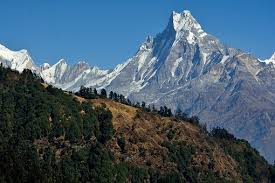Appalachian Mountains – Location, Rivers, Highest Peak, & Passes
Appalachian mountains, their location, rivers, highest peaks & Passes have always fascinated me. Welcome to the Appalachian Mountains, a magnificent mountain range that spans across the eastern United States, covering about 1,500 miles from Maine to Georgia. One of the world’s oldest mountain ranges, the Appalachians were created approximately 480 million years ago during the Ordovician epoch. The Appalachian Mountains are a great destination for anyone interested in nature, history, or just taking a beautiful drive.
So put on your hiking boots, gather your belongings, and prepare to discover this amazing mountain range.
Location of Appalachian mountains

Appalachian Mountains
The Appalachian Mountains are found in the eastern part of the United States.
It spans more than 1,500 miles from the state of Alabama in the south to the Canadian province of Newfoundland and Labrador in the north.
Maine, New Hampshire, Vermont, Massachusetts, Connecticut, New York, New Jersey, Pennsylvania, Maryland, West Virginia, Virginia,
Tennessee and North Carolina are among the thirteen states across which the range extends.
Important Rivers originating from the Appalachian mountains
The Appalachian Mountains are a vast mountain range that stretches across the eastern part of North America, covering over 1,500 miles
from Newfoundland in Canada to Alabama in the United States.
The mountains are the source of several important rivers in the region. Some of the major rivers that originate from the Appalachian
Mountains include:
Susquehanna River
The Susquehanna River is the longest river on the east coast of the United States.
It originates in Cooperstown, New York, and flows through Pennsylvania and Maryland before emptying into the Chesapeake Bay.
The river is approximately 444 miles long.
Potomac River
The Potomac River is another major river that originates in the Appalachian Mountains.
It begins in West Virginia and flows through Virginia, Maryland, and Washington, D.C. before emptying into the Chesapeake Bay.
The river is approximately 405 miles long.
James River
The James River is a major river in Virginia that originates in the Appalachian Mountains.
It begins in the Allegheny Mountains and flows through the cities of Richmond and Jamestown before emptying into the Chesapeake Bay.
The river is approximately 348 miles long.
New River
The New River is one of the oldest rivers in North America and is a major tributary of the Ohio River.
It originates in North Carolina and flows through Virginia and West Virginia before emptying into the Ohio River.
The river is approximately 360 miles long.
French Broad River
The French Broad River is a major tributary of the Tennessee River and originates in the Blue Ridge Mountains of North Carolina.
It flows through Tennessee and North Carolina before emptying into the Tennessee River.
The river is approximately 218 miles long.
Kanawha River
The Kanawha River is a tributary of the Ohio River and originates in West Virginia.
It flows through West Virginia before emptying into the Ohio River.
The river is approximately 97 miles long.
Highest Peak of Appalachian Mountains
Mount Mitchell, the highest point in the Appalachian Mountains, is found in western North Carolina’s Black Mountain range.
Mount Mitchell is the highest point in the eastern United States, rising 6,684 feet (2,037 meters) above sea level.
The Pisgah National Forest’s Mount Mitchell is a well-liked location for hikers and outdoor lovers.
The Mount Mitchell Trail, a challenging 5.6-mile round-trip climb that offers breathtaking views of the surrounding mountains and woods,
can be used by visitors to go to the summit of Mount Mitchell.
Many other significant peaks, in addition to Mount Mitchell, may be found in the Appalachian Mountains, including Mount Washington
in New Hampshire, which is the highest mountain in the northeastern United States.
In addition to Mount Mitchell, the Appalachian Mountains are home to numerous other notable peaks, such as Clingmans Dome in Tennessee, which is the highest peak in the Great Smoky Mountains National Park, and Mount Washington in New Hampshire, which is the highest peak in the northeastern United States.
How were the Appalachians formed?
During the Paleozoic Era, 480 million years ago, the Appalachian Mountains were formed.
The collision of numerous tectonic plates, including the North American Plate, the African Plate, and the South American Plate,
resulted in the process of mountain formation, known as orogeny.
Pangaea, an ancient supercontinent, was created as a result of the collision, and the Appalachian Mountains were raised as a result of the
Earth’s crust is compressed and folded.
From Canada to Alabama, approximately 2,000 miles of parallel peaks and valleys were formed as a result of this process.
The Appalachian Mountains’ complicated geological past is revealed by the layers of rock that have been exposed as a result of weathering
and erosion over time, which have worn down the peaks.
Today, the mountains are a diverse and important ecosystem, supporting a wide range of plant and animal species, as well as human
communities.
हिमालय-भारत का सबसे कमज़ोर पर्वत
7 interesting but unknown facts about Appalachian mountains
The Appalachian Mountains are a fascinating geological formation with a rich history and culture.
Here are seven interesting but lesser-known facts about the Appalachians:
Firstly, The Appalachians are some of the oldest mountains in the world, with their formation dating back over 480 million years.
Secondly, It runs from Georgia to Maine and is the longest hiking-only trail in the world, stretching over 2,200 miles.
Thirdly, these mountains are home to a unique ecosystem with over 1,500 species of plants and more than 400 species of vertebrate animals, many of which are found nowhere else in the world.
Fourthly, these Appalachian Mountains are also home to the largest cave system in the world, the Mammoth Cave System in Kentucky.
Fifthly, the Appalachians have played a crucial role in the history of the United States, serving as a natural barrier to westward expansion and as a source of timber, coal, and other resources.
Finally, these Mountains are also home to a rich cultural heritage, including traditional music styles such as bluegrass, old-time, and gospel music.
Moreover, the Appalachian Mountains are believed to have been named after the Apalachee tribe, who inhabited the region before the arrival of European settlers.
Important Passes in the Appalachian mountains
The Appalachian Mountains, stretching over 2,000 miles from Canada to Alabama, are dotted with many important passes, or gaps, that have played a crucial role in the history of the region.
Here are a few of the most significant passes in the Appalachian Mountains:
Cumberland Gap:
Located on the border of Kentucky, Tennessee, and Virginia, Cumberland Gap is one of the most important passes in the Appalachians.
It served as a gateway to the west during the frontier era, allowing settlers to cross the mountains and explore new lands beyond.
Wind Gap:
Located in eastern Pennsylvania, Wind Gap is a natural pass through the Blue Mountain ridge that has been used as a transportation corridor
for centuries.
Today, it is crossed by U.S. Route 22, which connects the Lehigh Valley to the Pocono Mountains.
Roan Mountain Gap:
Located on the border of North Carolina and Tennessee, Roan Mountain Gap is a popular hiking destination and a historic route that was
used by Native Americans, pioneers, and Civil War soldiers.
New River Gap:
Located in southwestern Virginia, the New River Gap is an important transportation corridor that has been used since prehistoric times.
Today, it is crossed by Interstate 77 and U.S. Route 52.
Blandford Nature Center:
Located in Michigan, Blandford Nature Center is a natural pass through the Appalachian Mountains that has been used by Native Americans
and early settlers for thousands of years.
Most popular spots in the Appalachians
The Appalachians are a vast mountain range that stretches over 2,000 miles from Canada to Alabama, encompassing a variety of landscapes, ecosystems, and cultural sites.
Here are some of the most popular spots in the Appalachians:
Great Smoky Mountains National Park:
Located in Tennessee and North Carolina, this is the most visited national park in the United States. It features stunning mountain vistas,
waterfalls, and diverse wildlife.
Blue Ridge Parkway:
A scenic road that runs for 469 miles through the Appalachian Mountains, connecting Shenandoah National Park in Virginia with the Great
Smoky Mountains National Park.
Shenandoah National Park:
Located in Virginia, this park is known for its scenic Skyline Drive, which offers stunning views of the surrounding mountains.
Acadia National Park:
Located on the coast of Maine, this park includes a rugged coastline, pristine forests, and stunning mountain scenery.
Mount Washington:
Located in New Hampshire, this mountain is the highest peak in the Northeastern United States and offers breathtaking views of the
surrounding White Mountains.
Chimney Rock State Park:
Located in North Carolina, this park features stunning rock formations, hiking trails, and panoramic views of the surrounding mountains.
Seneca Rocks:
Located in West Virginia, this distinctive peak offers excellent rock climbing and hiking opportunities.
New River Gorge National Park and Preserve:
Located in West Virginia, this park offers scenic views of the New River, as well as excellent whitewater rafting, rock climbing, and hiking.
Cades Cove:
Located in Tennessee, this valley offers a glimpse into Appalachian history and culture, with preserved historic buildings and scenic drives.
Natural Bridge:
Located in Virginia, this geological wonder is a 215-foot-high natural limestone arch that spans Cedar Creek, offering stunning views of the
surrounding forest
Conclusion:
This beautiful range is home to numerous plant and animal species, including approximately 170 bird species, 75 mammal species, and innumerable plant and bug species. Native Americans who have been residing in the Appalachian Mountains for a very long time include the Cherokee, Catawba, and Shawnee. The Appalachians are known for their natural beauty and rich cultural past. But they also have a long history of mining, logging, and other businesses. Since coal has long been a key source of energy in the US, the coal mining sector has played a large role in the area.
The Appalachian Mountains continue to be a natural gem despite industrialization and urbanization, drawing millions of visitors each year who come to hike, ride, fish, and take in the breathtaking scenery. The Great Smoky Mountains National Park, Shenandoah National Park, and the Blue Ridge Parkway are a few of the range’s well-known tourist destinations.





0 Comments